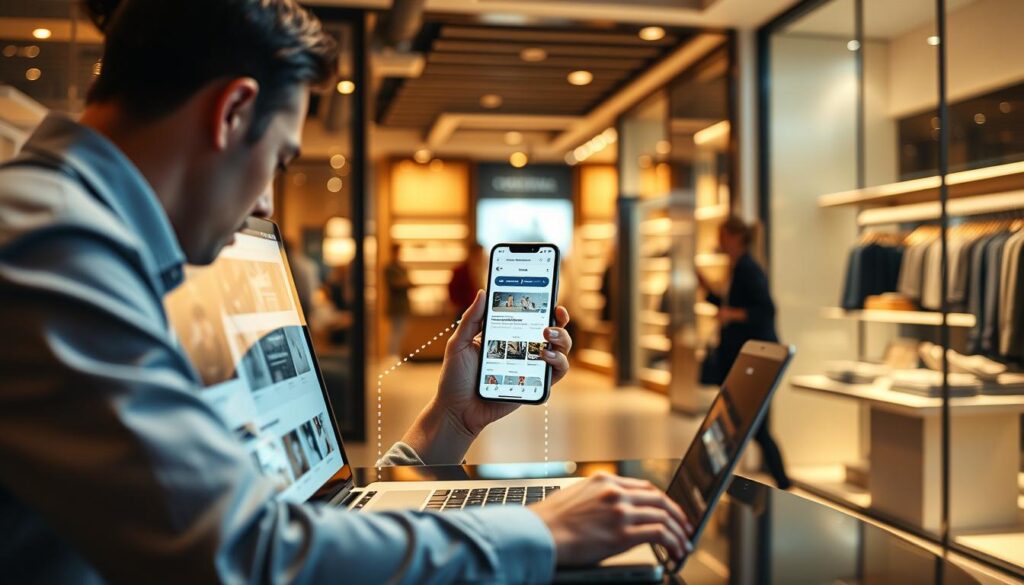Surprising fact: long, static forms can push over 80% of visitors to abandon before a single click.
We open with a single truth: low conversion is human, not just technical. People decide fast, mixing emotion and logic. That means your sales path must match how people think and act.
We set the agenda: align strategy to how customers move from discovery to a clear conversion goal. External marketing draws traffic; on-page attention guides choices. Small, staged asks and one-tap starts cut friction and protect ROI.
Macro Webber brings proven playbooks—mapping the journey, sequencing offers, and using micro-commitments so high-ticket brands convert with less effort and more trust.
Expect precise outcomes: optimized stages, clearer value, faster decisions, and predictable growth that turns visitors into customers.
Key Takeaways
- Align strategy to how people actually decide: fast, emotional, risk-aware.
- Prioritize calibrated value across each stage of the journey.
- Use micro-commitments and visible human signals to cut abandonment.
- Design one-goal pages that convert visitors into customers with less friction.
- Macro Webber provides playbooks to scale measurable sales and ROI.
Why Most Funnels Fail Today: The Human Factor You’re Overlooking
Most conversion paths fail because they treat clicks as metrics, not as moments shaped by human bias.
We see the same problem across premium business accounts: teams optimize for traffic and scale while missing how people actually decide.
At each stage—awareness via search, social media, or blog posts; consideration through helpful resources; and decision at a clear landing—behavior drives outcome.

Cognitive shortcuts like loss aversion, bandwagon effects, anchoring, and halo influence choices before logic does. The real problem isn’t pretty pages; it’s misreading intent.
- Fix the stage you’re targeting: awareness content that earns attention, consideration assets that educate, and decision pages that remove friction.
- Match messages to audience intent: stop blasting long email sequences and throwing ad spend at a weak value proposition.
- Leverage social proof and clear next steps: verify claims, show your team, and give one unmistakable action.
We’ll re-engineer your funnel around behavior so the right visitors make confident decisions that scale sales and protect your brand.
Funnel Design Psychology Fundamentals: Mapping the Customer Journey for Conversion
Successful conversion starts when we map each moment a visitor meets your brand. Map the journey into four tight stages so every interaction has a purpose.

Awareness → Consideration → Decision → Loyalty. Drive external attention with targeted traffic from ads, search, and social. Then pull internal attention on the page with pre-attentive cues and bold CTAs.
We align the value promise to intent: teach at awareness, compare at consideration, de-risk at decision, and reward at loyalty. Use BJ Fogg’s model to raise motivation—pair incentives with loss aversion tied to higher needs.
Action should be obvious. Reduce choices to a single next step on each landing experience. One stage, one objective, one primary CTA.
“Translate behavior into structure: clear steps beat cleverness every time.”
- Map the journey and set one measurable objective per stage.
- Sequence ads and content for discovery, then sharpen the page for conversion.
- Infuse human signals early—real teams, verifiable claims, local cues.
We close the loop with Hooked cycles: trigger, action, reward, investment—so retention becomes predictable and sales scale with less effort.
Psychological Triggers That Lift Conversion Rates
Targeted behavioral cues—used honestly—turn hesitation into decisive action for premium buyers.
We use ethical triggers that steer decisions without pressure. Each trigger targets a predictable bias so the buyer moves forward with confidence.
Loss aversion and urgency
Loss aversion speeds action. We add clear deadlines, limited cohorts, and time-bound bonuses to prevent postponement.
Scarcity, bandwagon, and social proof
Numbers reduce fear. Statements like “1,500 customers onboarded” and verified testimonials make cautious people more likely to buy.
Halo and anchoring effects
First impressions matter. Premium visuals and a presented standard price make the current offer feel like a bargain.
Clarity, consistency, and reciprocity
Specific benefits beat clever lines. We give immediate value—tools, a framework, or tailored content—then request a small yes.
- We deploy urgency and scarcity to convert intent into a fast decision.
- Pair proof with promise: verifiable testimonials and case data.
- Measure lifts in conversion rates, lower acquisition costs, and faster sales velocity.
Example: a short, time-limited cohort invitation increased trial sign-ups by a measurable margin without harming trust.
Micro-Commitments in Action: Designing Friction-Lite, Content-First Funnels
Momentum is a measurable asset: capture it with micro-actions that ask for almost nothing.
Begin with a feather-light step: one-tap starts, yes/no choices, or quick visuals. This removes initial friction and secures a first micro-yes.
Follow with one question per screen. Each short step lowers cognitive load and raises completion rates for users. The process feels faster and more human.
Insert value mid-flow. Offer a personalized tip, benchmark, or quick estimate before asking for contact. That earned ask converts more customer intent into action.
- One-field pages: split big forms into many small steps to lift completion rates.
- Progress bars: leverage the goal-gradient effect so people speed up as they near the end.
- Smart tools: calculators and conditional paths tailor the experience and improve sales outcomes in marketing tests.
| Tactic | Primary Payoff | Typical Lift |
|---|---|---|
| One-tap start | Lower abandonment | +15–25% rates |
| One question/screen | Higher completion | +20–35% rates |
| Mid-funnel value drop | Earned trust | +10–20% conversion |
| Progress indicator | Faster finish time | +8–18% completion |
From Traffic to Trust: Content, SEO, Social Media, and Landing Page Alignment
Acquisition only pays when every channel routes qualified visitors to a single, decisive outcome. We build a system that turns search intent into credibility and attention into measurable sales momentum.
High-intent traffic via content marketing and SEO
We use content and SEO to capture problem-aware searches. Blog posts act as round-the-clock sales reps that answer intent-rich queries and demonstrate category leadership.
Our approach: map keywords to buyer needs, create deep how-to assets, and tie each post to a clear next step that primes conversion.
Social media and ads: turning scrollers into engaged users
Social media and ads send low-intent traffic into micro-actions. We ask for small commitments first—a quick assessment, a checklist, or a sample insight—to earn attention.
These short wins escalate relevance and prepare visitors for a high-value ask on the landing page.
Landing page optimization: one clear offer, one action
A landing page must have one purpose. One offer, one action, and obvious benefits. Remove competing links and put proof high and tight: logos, quantified outcomes, and targeted testimonials.
We segment traffic by source, match the messaging, and capture insights in-flow so follow-ups are relevant. When content, social, ads, and page align, conversion rates rise and the brand earns trust that compounds into sales.
“Route traffic into segmented experiences; match message to source and sophistication.”
Reduce Friction, Increase Action: UX, Decision Simplicity, and Trust Signals
Users decide in seconds; remove friction that interrupts that fast decision. We simplify the path so each step earns a small yes and keeps momentum toward conversion.
Minimizing steps and choices
Strip options to essentials. Each extra field or button adds drag and feeds analysis paralysis. Break long forms into micro-steps and show progress.
Trust accelerators
Front-load trust: show real faces, credentials, and locations above the fold. Place proof near CTAs, pricing, and forms so doubt falls as confidence rises.
Risk reversal and transparency
Offer clear guarantees, simple terms, and anchored price comparisons. Transparent policies speed decisions on high-value buys and protect your brand.
- Limit choices; reduce form fields to essentials for faster completion.
- Display real team photos, up-to-date reviews, and verifiable credentials.
- Show proof adjacent to CTAs and near price information.
- Provide guarantees and clear refund terms to neutralize hesitation.
- Keep the page fast, scannable, and error-free; offer email, phone, and chat above the fold.
| Tactic | Impact | Enterprise Benefit |
|---|---|---|
| Micro-steps form | Lower abandonment | Higher completion and qualified leads |
| Front-loaded proof | Faster trust build | Reduced sales cycles for enterprise customers |
| Clear guarantees | Less hesitation | Higher close rates on big-ticket offers |
| Price anchoring | Stronger perceived value | Improved average deal size |
We remove friction systematically so decisions feel easy, trust feels immediate, and sales move faster.
Funnel design psychology: Real-World Playbooks and Pitfalls to Avoid
Tactics without sequence create noise; sequence with tactics creates predictable sales. We lay out a concrete playbook and the common errors that sap ROI for premium brands. Expect named examples and direct fixes that work at scale.
Russell Brunson’s “free book” is a classic example. He anchors perceived value by presenting a regular retail price, then offers the book for “free + shipping.” This lowers the entry price and triggers loss aversion with limited copies and countdowns. After the initial yes, ethical upsells—audio, video series, and premium coaching—scale lifetime sales.
What Brunson gets right
- Anchor the full price, then reduce friction with a shipping-only ask.
- Use scarcity and timers to convert browsing into action.
- Sequence upsells post-commitment so add-ons feel natural.
Sharp pitfalls to avoid
- Ignoring triggers: no urgency, no proof, no clarity—stalls revenue.
- Wrong audience or stage targeting—wasted ads and traffic.
- Vague value, thin content, or missing pricing context—premium buyers need specifics and guarantees.
| Playbook Element | Why It Works | Common Failure |
|---|---|---|
| Anchor + free offer | Raises perceived worth | No price context; looks cheap |
| Scarcity & timers | Drives decisive action | Artificial or missing urgency |
| Post-sale upsells | Higher lifetime sales | Poorly aligned add-ons |
We apply smart tools and content blocks to personalize flows, validate claims with case-level proof, and tune each stage so people convert with confidence. We refine your playbook to protect brand trust while increasing predictable sales.
Optimization That Compounds: Testing, Segmentation, and Lifecycle Nurturing
Optimization must become a repeatable engine, not a one-off sprint. We build a system that turns behavior signals into tailored messages and measurable conversion gains.
Segment by action. Who clicked pricing, who downloaded a guide, who returned—each group gets a distinct path. Matching messages to stage reduces friction and raises conversion rates.
Behavior-based segmentation
We map visitor actions to segments and move them along the customer lifecycle. That clarity lets email and ads push the right insights at the right time.
Email journeys that educate and convert
Our emails teach first, then invite demos and sales. Each sequence delivers small wins, builds trust, and advances qualified customers toward a decision.
Iterative A/B testing
Test headlines, CTAs, form fields, and proof placement. Track micro-step rates and remove remaining friction at the bottom of the path.
- Use tools for rapid iteration: templates, analytics, heatmaps.
- Personalize by problem and stage to accelerate experience to outcome.
- Align marketing and sales with shared data to stop leaks and scale results.
| Focus | Metric | Tool | Expected Lift |
|---|---|---|---|
| Behavior segments | Engagement rate | CDP / Analytics | +10–25% |
| Email journeys | Demo conversion | ESP / Automation | +8–20% |
| Page tests | Conversion rate | A/B tool / Heatmap | +5–30% |
| Lifecycle nurture | Customer LTV | CRM / Success | +15–40% |
We turn optimization into an operating system: disciplined tests, behavior segments, and lifecycle care that compound predictable sales for your business.
Conclusion
A focused set of changes can flip weeks of wasted traffic into measurable sales momentum.
We engineer each stage so one landing objective and clear messaging drive action. Winning brands center people first—clarity, trust, and proof built into every page to turn traffic into customers.
Now is the time to compress time-to-impact. Secure Macro Webber’s Growth Blueprint or book a consultation and we will audit your funnel, prioritize wins, and map an execution plan that raises sales and protects brand equity.
Limited availability: slots fill fast. Act now to lock in faster results, fewer steps, and a tested system that scales your business.



